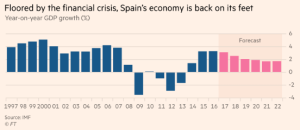
From banks to shopping, property and tourism, many sectors are playing their part in Spain’s recovery.
The Financial Times has published a growing health check report on Spain’s exceptional economic recovery, using a series of charts and graphs to clearly illustrate just how well the country’s fortunes have turned around…
Led by the upturn in construction and a growing tourism sector, Spain has become one of the continent’s most dynamic economies.

Following a 35% reduction in property prices between 2008 and 2014, and a series of mortgage defaults that left Spain’s banks as the nation’s largest property owners, the past three years have been characterised by a steady recovery in prices and interest.
The real estate construction sector is on course for a compound annual growth rate of 3.4% through to 2020, having experienced a contraction of 5.7% in the years between 2011 and 2015.
“Construction activity in Spain is seeing a resurgence,” CBRE Spain Chief Executive Adolfo Ramírez-Escudero told the Financial Times. “The demand is there and companies are building again.”
Spain owes its recovery in part to the tough but necessary labour reforms that were introduced by Prime Minister Mariano Rajoy in 2010. These measures made it easier for companies to fire – and therefore hire – employees, and while the new laws have suppressed wages and eroded job security in some sectors, they did have the effect of liberalising the job market.
This coincided with the ending of the global credit crunch, which meant other Europeans – namely Brits and Scandinavians – were once again eager to travel and invest once more, with Spain firmly on their map.
Spain’s major equity index, the Ibex 35, is performing more strongly than similar indices in the UK, shoring up the country’s vital banking industry – which has also reaped the benefits of a stronger real estate sector.
“For the majority of the post-crisis period, exposure to real estate had been a curse for the Spanish banks,” José Abad, banks analyst at Goldman Sachs, told the Financial Times, adding that the improvement in the sector has led to a “regime shift” as bad loan provisions were reduced.
Beyond banking, construction and tourism, Spain’s retail sectors have also been boosted by robust high street spending among Spaniards, particularly those who have been able to return to Spain for work and are optimistic about their own futures.
The charts and the graphs created by the Financial Times do a great job of showing just how Spain has turned a corner, and are well worth checking out.
 en
en



 Vlaams-Nederlands
Vlaams-Nederlands
0 Comments
Leave a Comment
DISCLAIMER
The opinions and comments expressed by contributors to this Blog are theirs alone and do not necessarily reflect the views of VIVA Homes Under the Sun Ltd, any of its associated companies, or employees; nor is VIVA to be held responsible or accountable for the accuracy of any of the information supplied.
Have you got something to say?